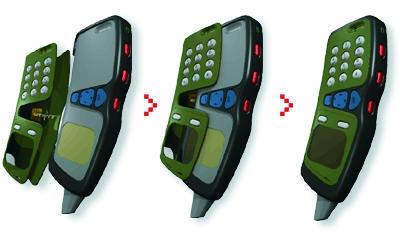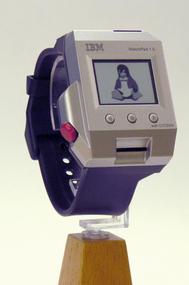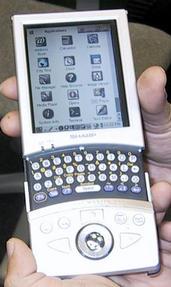

Rick takes a look at a pair of recent announcements ofinteresting new gadgets with Linux embedded inside.
GITWiT (Kirkland, Washington) is currently developing a Linux-based wireless handset that combines communications and entertainment within a uniquely customizable two-part design. The company plans to aim the device at the lucrative teen market initially by offering a colorful phone with cool teen-oriented capabilities.
According to GITWiT's market research, roughly 25% of the 40 million teens in the US own wireless phones today, leaving 30 million potential additional subscribers up for grabs.
Physically, the GITWiT phone consists of two pieces (see photo). The GITWiT-enabled handset contains the core telephony functionality. A software-enabled cover, called a Smart Skin, snaps onto the handset core to define a specific and easily alterable look, feel and wireless-user experience.

GITWiT Phone's Two-Part Design
Each Smart Skin contains a Smart Key, which is built around an industry standard, secure smart card module. Smart Keys contain encrypted data and software that changes the wireless-user experience to match the theme of the skin.
As an example, users snapping on skins branded by their favorite music group might get a new look and feel for the user interface, plus customized ring tones and graphics, preconfigured wireless web bookmarks and subscription content for the group's latest CDs and upcoming concerts.
GITWiT expects its innovative approach to be popular with wireless carriers because it permits them to embrace changing fashion and entertainment trends rapidly by refreshing the relatively expensive core cellular component with an inexpensive snap-on Smart Skin.
From a technical perspective, GITWiT-enabled handsets are composed of three main parts: a cellular processor, a proprietary Smart Key operating system and an embedded host processor.
The host processor, an embedded computer running Linux, is the heart of the phone. It is built around an ARM7 microprocessor and contains a number of embedded peripherals and I/O interfaces for the keypad, color LCD and for communicating with the Smart Skins. A separate cellular processor handles all of the on-air cellular communications.
GITWiT uses the 2.4.5 Linux kernel with ARM patches from Russell King and Nicolas Pitre, as well as a number of in-house patches. The system software also includes portions of Microwindows for its GUI, as well as BusyBox.
“We chose Linux for a number of reasons”, explains GITWiT VP of Engineering Peter Zatloukal. He continues:
We are building a user interface that is leagues beyond what exists on current wireless phones, and Linux provides us with a rich environment with which to render our ideas.
Also, since most of our development work is in the application and object layers, we're glad to be using an open-source kernel so that we can contribute to efforts that make it easier for others to develop embedded solutions.
We feel that increasing the ease of innovation in the embedded space, even if it also strengthens our competitors, helps us because it broadens the whole market. We like the world where low barriers to entry fuel competition around what really matters—a richer wireless-user experience.
See www.GITWiT.com for more information.
IBM Research and Citizen Watch have announced a collaboration through which Linux-based WatchPad prototypes and related technologies are being developed. The collaborative project, which builds on IBM's earlier Linux Watch efforts, has the goal of exploring a new type of personal information access devices for the pervasive computing era. IBM Research first demonstrated the Linux Watch last year, in an effort to illustrate the viability of Linux across all platforms, from the S/390 to the smallest intelligent devices.

The IBM/Citizen WatchPad
Citizen Watch decided to work with IBM to develop enhanced features and new technologies for use in future “intelligent watches”, such as using them as communication devices. Thus far, Citizen Watch has contributed packaging and component design, including display and input device. IBM provided the hardware architecture, system design and software—including Linux. The two companies also say they plan to collaborate with universities by sharing the WatchPad technology for joint research, in hopes of accelerating progress in the development of next-generation intelligent devices.
The WatchPad contains a high-speed, low-power 32-bit MPU, 16MB of Flash memory and a quarter-VGA (320 × 240 pixels) LCD. Wireless connectivity includes both Bluetooth and infrared. Users interact with the device through a touch panel, buttons and modified winding knob. In addition, an accelerometer is embedded in the device to explore the possibility of arm movement being used as an input method.
Here are a few key technical specs of the WatchPad, taken from a fact sheet distributed by IBM Research:
Hardware
Size: 65mm × 46mm × 16mm
Weight: 43g (without wrist band)
CPU: high-speed, low-power 32-bit MPU (18-74MHz)
Input devices: touch panel, a winding crown switch, button
Display: 320 × 240 dots, monochrome liquid crystal display
Memory: 8MB low-power DRAM, 16MB Flash
Interfaces: Bluetooth wireless technology (v1.1, voice-enabled), IrDA (V1.2), RS-232C (via a cradle)
Others: speaker, microphone, vibrator, fingerprint sensor, accelerator sensor
Power: Li-Ion battery
Cradle: RS-232C, AC adaptor and AA batteries
Software
Operating system: Linux kernel version 2.4
GUI: Microwindows
Bluetooth stack: IBM BlueDrekar (L2CAP, SDP, RFCOMM)
Sharp Electronics is taking orders for their Zaurus SL-5000D (developer edition) Linux/Java PDA from developers beginning in November 2001. The price for the developer model is $399 US, and it includes 32MB DRAM and 16MB Flash.
The device is based on a 206MHz Intel StrongARM system-on-chip processor, and it has a 3.5" 240 × 320-dot pixel (quarter VGA) reflective TFT 65,536 color LCD with touch-panel support and, of course, runs an embedded Linux operating system. The software stack is based on Lineo's Embedix, Trolltech's Qt Palmtop Environment, Opera's web browser and a PersonalJava v1.2-compliant Java runtime environment. Two expansion slots are provided: a secure digital (SD) card slot, used mainly for Flash memory, plus a CompactFlash slot used for communications interfaces, a digital camera attachment, Flash memory and more.
A unique and highly desirable feature of the SL-5000D is its full QWERTY keyboard, which is accessed by sliding the bottom portion of the device downward. See developer.sharpsec.com for more information.


Zaurus SL-5000D Linux/Java PDA
Rick Lehrbaum (rick@linuxdevices.com) created the LinuxDevices.com “embedded Linux portal”. Rick has worked in the field of embedded systems since 1979. He cofounded Ampro Computers, founded the PC/104 Consortium and was instrumental in creating and launching the Embedded Linux Consortium.